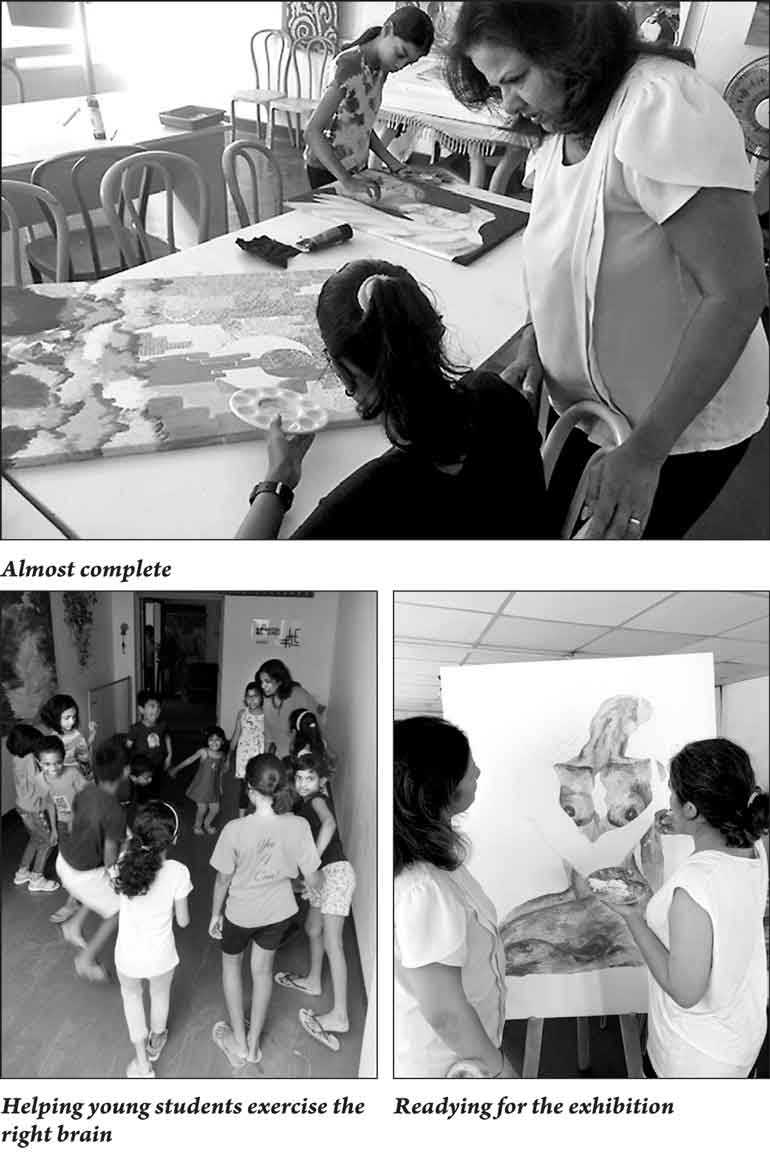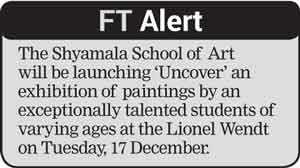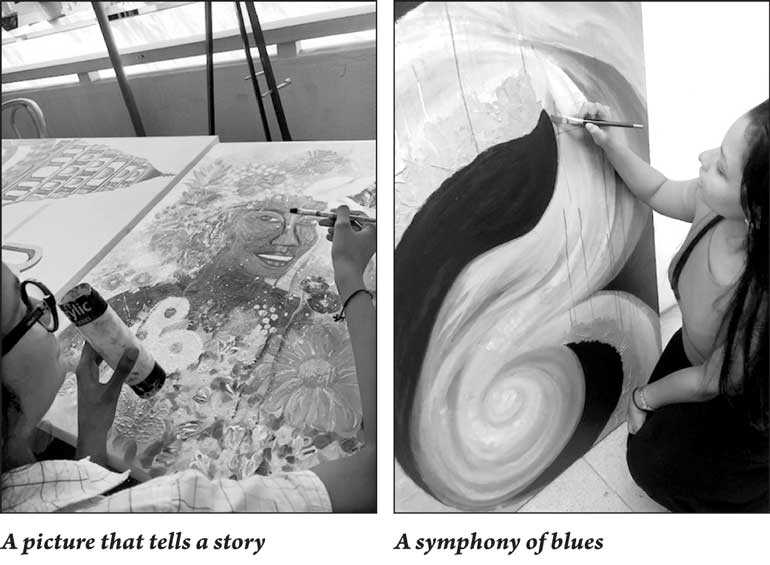Wednesday Dec 10, 2025
Wednesday Dec 10, 2025
Saturday, 14 December 2019 00:02 - - {{hitsCtrl.values.hits}}

By Tyron Devotta
Teaching fine arts to students and developing it to an international standard can be a challenge in Sri Lanka, primarily because the majority of Sri Lanka does not operate with English as a skill. Shyamala Pinto Jayawardene says the colloquial Sinhala word ‘Kaduwa’ demonises the use of the English language and is the bane of higher education in Sri Lanka’s state universities.
Shyamala who was educated in a Colombo school and graduated from the Kelaniya University says, being English educated is looked at with distaste by our local universities. This she says is the first stumbling block in expanding one’s horizons.
“Fine arts are not just about painting a picture – There is so much to learn. Apart from Greek and Roman culture, Indian influences and other cultures around the world, the common language is English.”
While she does not dismiss the rich Sri Lankan heritage in the sphere, Shyamala says there has to be a proper plan in higher education to teach English language to everyone, “so that this great vacuum in English knowledge can be filled”.
Shyamala Pinto Jayawardene who is an art teacher for over 40 years now, and runs an art school in Colombo, is of the view that any student who wants to pursue a career in Fine arts must do art as a subject for both O Levels and A Levels, because it provides the grounding they need.
The problem she says is the fact that the vast majority in Sri Lanka refuses to accept fine arts as the base for subjects like interior design, architecture or even graphic design. However, this is not the case with London O/Ls and A/Ls which include Art as a subject, providing great opportunity internationally, for students who start out in fine arts from a tender age.
With the 4th Industrial Revolution threatening to disrupt jobs, society around the globe is changing mainly due to shifts in technological capacity. Therefore, higher education must change with it. In order to do that, a model needs to be formed, so that a future ready workforce with ways of thinking and working that would be in demand in the Fourth Industrial Revolution (4IR) would emerge.
 Jobs are increasingly becoming automatable, which means a great deal of our workforce would have to be upskilled and retrained in the near future. Sri Lanka’s education system focuses on STEM learners, where students learn to the test. This was useful in creating a workforce that crunches and manages numbers efficiently.
Jobs are increasingly becoming automatable, which means a great deal of our workforce would have to be upskilled and retrained in the near future. Sri Lanka’s education system focuses on STEM learners, where students learn to the test. This was useful in creating a workforce that crunches and manages numbers efficiently.
However, what does not come with this sort of preparation is creative and critical thinking. So, it is time to create a new approach which no longer expects students to seek the highest possible academic attainment at as young an age as possible — instead, they need to learn and acquire new skills throughout their lives. It is important that these skills-based training programs and primary as well as secondary school education systems, place emphasis on how to learn and not what to learn. “Today children hardly go on field trips. As an art teacher I do my field trips and we go looking for the little things that often go unnoticed. Maybe just looking at the different gestures and facial expressions of villagers and how these change from place to place... that’s when children become sensitive to people they would otherwise never meet in their lives. And this becomes a way of understanding, and allowing oneself to melt into the social fabric which would have a great impact on what they create as artists,” says Shyamala.
Speaking of degrees available from local institutions affiliated to foreign universities, she says there is not enough emphasis in capturing the Sri Lankan ethos. Whilst some of them do attempt to connect there is still not enough of a proper balance. Because the English language has become a barrier.
“We harass our children to develop maths and to develop science subjects. But we don’t talk about the right brain,” stressing on the point of balance between the left brain and the right brain she says the anatomy of a human being is constructed in such a way as to accommodate the simultaneous functioning of both the left brain and right brain. However, centuries and centuries of focusing our attention on the development of the left brain has made what we call a “balanced human being” almost redundant.
Quoting Cambridge professor, Shankar Balasubramaniam, she says all the education of the left brain is of no value if we do not develop the right brain. If we continuously developed the right brain faculties, the left brain will be balanced and will even complement each other, thereby facilitating the creation of a human being who is balanced in everything he says and does.
Shyamala is of the view that in preparing kids for the future, most jobs are in danger of being disrupted. “There has to be a holistic approach, and not an over emphasis on logical and objective thinking. While this certainly could not be ignored, the right brain stimulation which has been neglected for centuries has to be seriously looked at if we want to meet the challenges of the future.”
The Shyamala School of Art will be launching ‘Uncover’ an exhibition of paintings by an exceptionally talented students of varying ages at the Lionel Wendt on Tuesday, 17 December.
Located at No. 3 Siripa Road, the Art School is the only private institution in Sri Lanka with British Council accreditation to offer Art and Design as a subject right up to Advanced Level. The school preps students for Art and Design as a subject for both Edexcel and Cambridge examinations and also facilitates Art & Design students who wish to do London O/Ls and A/Ls privately, by helping them to sit for subjects such as Psychology, History and English Literature, via the school.
